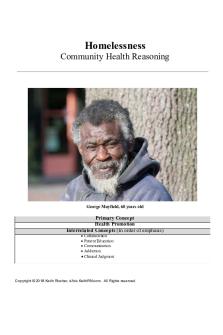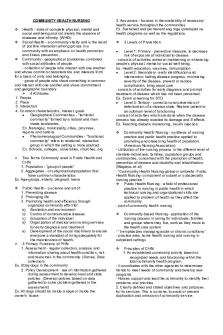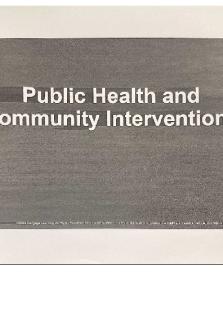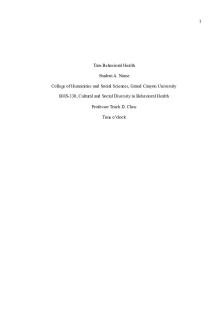Community health final PDF

| Title | Community health final |
|---|---|
| Author | Sandra Torres |
| Course | Medical-Surgical Nursing |
| Institution | Miami Dade College |
| Pages | 14 |
| File Size | 239.1 KB |
| File Type | |
| Total Downloads | 18 |
| Total Views | 169 |
Summary
mental health nursing...
Description
COMMUNITY FINAL QUIZ 1. A nurse is providing psychological counseling at a community center for families whose loved ones died in a fire. After learning that both of her children perished in the fire, a mother says to the nurse, "I can't believe they are gone. How will I make it through this?" Which of the following is an appropriate response by the nurse? A. "You are feeling overwhelmed right now" B. "Don't worry. You will have plenty of help" C. "Can I call someone to be here with you?" D. "Anyone who has had a loss like this would feel that way" In this response, the nurse uses the therapeutic communication skill of restatement to encourage further expression of feelings by the client. 2. An industrial health nurse is caring for a female employee who is requesting some medication for a headache. The nurse asks if the client knows what could be causing the headache, and the client states, "I have been under a lot of stress lately." When the nurse suggests stress management techniques, the client calmly states that she intends to take her life after work that day. She further reports that she has a pistol in the car, and that she intends to kill herself in the parking lot of the plant. Which of the following actions should the nurse take first? A. Have the company's security officers search the client's car and remove the pistol B. Call emergency medical services to transport the client to a proper treatment facility C. Contact the client's family member to pick her up from work and take her for treatment D. Explore with the client the reasons she feels that she has no options except suicide Client safety is the nurse's primary concern. The client must be transported, safely, to a treatment facility as soon as possible. In addition, the nurse should not leave the client alone until the client is safely evaluated by or admitted to a proper care facility. 3. A home health nurse is doing an assessment of an older adult client's home. Which of the following findings should the nurse realize may be the greatest potential hazard? A. a walk-in shower B. a straight staircase with arm rails C. a large area rug in the living room D. a small rug in front of the kitchen sink Small rugs that are not attached to the floor are the greatest potential hazard to the client, due to risk for falling 4. A nurse is educating a community group who lives near a nuclear power plant. The nurse is providing information about safety related to radiation exposure when a client asks "Isn't there something we should have on hand in case of a nuclear disaster?" The nurse should recognize that the client is referring to which of the following? A. potassium iodide (Pima) B. potassium cyanide C. ciproflaxcin (Cipro) D. atropine (Atropine sulfate) Potassium iodide, if taken in time and at the appropriate dosage, blocks the thyroid gland's uptake of radioactive iodine and thus could reduce the risk of thyroid cancers and other diseases that might otherwise be caused by exposure to radioactive iodine that could be dispersed in a severe nuclear accident. 5. A nurse is planning to participate in a public education program related tp prevention of West Nile virus. Which of the following instructions should the nurse include in the presentation? A. eliminate sources of standing water
B. make sure immunizations are up to date C. keep all pets indoors D. Spray nests with N,N-Diethyl-m-toluamide (DEET) At least once or twice a week, clients should empty water from flower pots, pet food and water dishes, birdbaths, swimming pool covers, buckets, barrels, and cans. Discarded tires and other items that could collect water should also be removed. 6. A nurse is performing a community assessment in a rural setting. The nurse is aware that the type of health care that is most likely to be absent in this setting is which of the following? A. Tertiary care B. Primary prevention C. Chronic care D. Secondary prevention Tertiary care, or specialized consultative care, is usually obtained following a referral from a primary care provider. Specialists, typically working in a center that has personnel and facilities for special procedures, such as large medical centers, provide tertiary care. This level of care is not readily available in most rural settings. 7. A nurse manager at a clinic for homeless people notes that many of the clients have a history of mental illness and also have difficulty with abuse of drugs or alcohol. Many of the clients require treatment for both mental illness and substance addiction. While compiling figures for a regulatory agency about the clients who visit the clinic, the nurse classifies these clients as having which of the following? A. Codependency B. Bipolar disorder C. Co-morbidity D. Somatization disorder Comorbidity is the presence of more than one disease or health condition in an individual at a given time. It may also be called a concomitant disorder or dual diagnoses 8. A nurse is conducting teaching for a client who has been prescribed Ciprofloxacin (Cipro) following exposure to anthrax. The nurse understands that the client needs additional teaching when the client states which of the following? A. "I will limit my intake of coffee, tea, or cola beverages" B. "I will wear a large-brim hat and long sleeves if I am out in the sun" C. "I will take the ciprofloxacin with an antacid if I get an upset stomach" D. "I will avoid taking cirpofloxacin along with dairy products" Ciprofloxacin is an antibiotic prescribed for a wide range of serious skin infections and is also effective against inhalation anthrax. Taking ciproloxacin with antacids can impair the absorption of the medication, reducing its effectiveness. 9. A nurse is educating a community group on smallpox. When discussing the possible means for the transmission of smallpox, which of the following statements by a member of the community group indicates a need for further teaching? "Smallpox can be transmitted through... A. bodily fluids, such as blood or vomit" B. contaminated objects, such as bedding and clothing" C. bites from insects, such as mosquitoes" D. inhalation of droplets, such as from coughing" Animals and insects have not been shown to be vectors for the smallpox virus 10. A nurse is caring for employees and their family members who have become ill after a company picnic. After extensive interviews and a review of the food handling practices, the nurse determines that
the most likely cause of the illnesses was a poultry dish that had been allowed to cool to room temp for several hours before being served. This step in the epidemiological process is called which of the following? A. planning B. assessing C. implementing D. evaluating This step in the epidemiological process identifies the problem and provides the information necessary to plan interventions designed to prevent outbreaks of food borne illnesses 11. A nurse is responding to a community-wide request for health care providers to come to the scene of a bomb explosion. Reporting to the disaster scene coordinator, the nurse is told that as the victims are rescued they are triaged, and either transported or sent to the parking lot for a secondary assessment. The nurse is asked to assist in the secondary assessment process to do which of the following? A. evaluate effectiveness of resuscitation B. identify life-threatening injuries C. initiate treatment of airway and breathing problems D. determine the extent of additional injuries The secondary assessment begins after the primary (triage) assessment is completed and life-threatening injuries are addressed. The object is to determine the extent of the client's injuries so that the nurse can help determine the order in which a large group of clients with less critical injuries will be treated and transported 12. A nurse working in the ED is notifiedd by the county's emergency medical services that there has been a multiple casualty accident involving a truck carrying radioactive waste. The ED charge nurse should take which of the following actions first? A. designate a decontamination area to accommodate irradiated victims B. Notify the admissions office to clear as many critical care beds as possible C. Clear the department of all non-urgent clients and move those awaiting admission to a holding area D. notify emergency medical services of the number of casualties the department can accommodate The nurses immediate priority is to clear the ED of non-urgent clients and open up as many treatment areas as possible to receive victims 13. A community health nurse should know that, in the event of a smallpox bioterrorism threat, a mass inoculation plan would first target which of the following groups? A. newborns B. mortuary workers C. immunosuppressed clients D. clients who have eczema Smallpox is an extremely contagious, disfiguring, and deadly disease caused by the variola virus. Particles containing the virus are released into the air when an infected person coughs, sneezes or talks. Particles may also spread through direct contact, which can occur through contact with contaminated bed linen and clothing. 14. A home health nurse is caring for a client who is living in a mental health group home. During one of her visits, the nurse discovers that the client has been hoarding psychotropic medications. The nurse's initial response should be to do which of the following? A. have the client transported to an acute care facility B. attempt to determine the reason for the client's hoarding behavior C. reprimand the staff that has been administering the client's medications D. demand that the client relinquish the medication immediately
The client may be hoarding the medications for a variety of reasons. He may not like the side effects of the medications, or he may be planning to overdose to end his life 15. A nurse is working in a triage area. Which of the following activities is unlikely to be a responsibility of the nurse in this setting? A. fostering positive public relations for the hospital B. performing a complete and comprehensive client assessment C. preventing cross contamination of infectious clients D. educating the client and family In the triage setting, the nurse's priority is assessment and control of client flow. The triage nurse does not use time to provide education to the client or family Education is handled by the ED staff once treatment of the client begins 16. A nurse is working in the ED when several hundred clients injured in a train collision arrive at the hospital for treatment. The triage nurse should determine that which of the following clients is in need of immediate treatment? A. a client who has neck pain and was transported to the hospital on a backboard B. a client who has epigastric and left arm pain and is diaphoretic C. a client who has nasal and orbital ecchymosis and epistaxis D. a client who has abdominal pain and is 2 months pregnant The triage nurse should recognize that a report of severe epigastric and left arm pain accompanied by diaphoresis is a classic sign on MI, which is a life-threatening emergency. This client is in need of immediate treatment 17. A public health nurse is visiting an older adult client who has chronic airflow limitation disease and is a former cigarette smoker. The client's medications include ipratropium (Atrovent) and albuterol (Proventil) inhalers, and the client has just been prescribed home oxygen to use as needed. The nurse should recognize that this client's primary prevention needs include which of the following? A. periodic pulmonary function tests B. review of appropriate use of oxygen in the home C. yearly mammography exams D. annual influenza immunizations Immunizations is a classic example of primary prevention. This client should receive influenza immunizations annually 18. In the aftermath of a large earthquake, a hospital's disaster plan is put into effect. The charge nurse must assemble a list of clients that can be safely discharged home to accommodate the anticipated admission of many victims. The charge nurse knows that it is unsafe to discharge which of the following clients? A. a client who has osteomyelitis and will require 6 weeks of IV antibiotic therapy B. a client who has Crohn's disease and is 1 day pre-op for an ileostomy C. a client who has Alzheimer's disease and is awaiting placement in a long term care facility D. a client who has an ileus following spinal surgery 5 days ago and is ambulatory in a brace This client is NPO; therefore, the client will lack bowel sounds and have a distended abdomen. This client requires nasogastric suction and cannot be discharged safely to home 19. A nurse in an ED is informed that a tornado touched down in a nearby town and that mass casualties are en route to the ED. The charge nurse's initial action should be which of the following? A. follow agency policy to activate the disaster plan B. prepare the triage rooms
C. obtain additional supplies D. call in off-duty staff The nurse has little information other than several clients are expected in a short period of time. The best way to deal with this situation is to follow the agency policy for activating the disaster plan (this may mean calling the nursing supervisor or the administrator on call). The disaster plan will then delineate the roll and responsibilities of all responders, ensuring that clients are treated in a safe and orderly manner by adequate numbers of caregivers 20. A public health nurse in a community recently hit by a devastating tornado is concerned about the mental health of the community members. The nurse decides that which of the limited resources the most cost effective approach is to conduct a depression screening. The goal of the nurse's secondary prevention effort should be which of the following? A. to increase the level of awareness of depression's manifestations in the community B. to decrease the incidence of depression in the community C. to prevent the development of depression in the community D. to provide treatment to clients in the community who are at risk for depression The goal of secondary prevention actions, such as depression screening, is to identify clients who have manifestations of a disease or condition so that referrals can be made for proper treatment. Early detection through secondary prevention may help to minimize the impact of the disease. 21. A school nurse is called to the scene of a large fight that just ended. The school security officers have called the police to the scene. Which of the following actions should the nurse take first? B. triage the injured students C. provide support to help staff deal with traumatic situation D. assist in the restoration of security on the grounds The nurse from a community center will likely be the first medical responder to the site; the nurse will need to begin triaging the injured clients to assist medical personnel as they arrive 22. A community health nurse should be aware that demographic modifying factors influencing healthy behaviors include which of the following? A. family health patterns B. income and educational levels C. self-esteem D. perceived health status demographics are the statistical characteristics of human populations, such as age or income. Income and educational levels are modifiable demographics that influence a client's performance of healthy behaviors 23. A nurse is teaching a sex ed class when a student informs the nurse about having sexual intercourse with a partner who might be HIV positive. The student asks the nurse what to do. Which of the following is an appropriate response by the nurse? A. "You shouldn't worry, yet. You don't even know if your partner is HIV positive." B. "Have you confirmed that your partner is HIV positive?" C. "Would you like to have an AIDS test done?" D. "Did you use protection, such as a condom?" Obtaining this information by clarification will prevent a misunderstanding and allow for the appropriate direction 24. A nurse is caring for a client who has a positive mantoux skin test following screening for tuberculosis (TB). The nurse should inform the client that the positive reaction indicated which of the
following? A. the client has never been exposed to the tubercle bacillus B. the client had infectious TB at one time but it is not inactive C. the client has active TB D. further evaluation is required A positive Mantoux test indicated only that the person has been exposed to the tubercle bacillus, and further evaluation will be needed through the use of sputum cultures and chest x-rays 25. A nurse is planning a health fair for a local community. Which of the following should be the nurse's most important consideration when deciding which screening programs will benefit the population the most? A. Identify prevalent health problems in the community B. Identify health care facilities available to clients in the community C. Identify cost of the screening programs D. Identify demographics of the community Knowing the most prevalent health problems of a population will help the nurse to decide which screening programs are needed most and which to make available 26. A nurse is recommending tai chi course to an older adult client. The nurse should inform the client that tai chi may have which of the following effects in older adult clients? A. improve vital capacity and tidal volume B. improve wound healing and prevent infection C. improve balance and decrease the risk for falls D. improve cognition and short-term memory Tai chi is an ancient Chinese martial art program consisting of a series of slow, gentle, continuous movements. Older adult clients who take part in structured tai chi programs improve their balance and physical strength, which reduces the risk for falls 27. A nurse is planning a teaching session at a community center about the prevention of mortality related to suicide. The nurse plans to target the population at greatest risk. The nurse should know that which of the following groups of clients is most at risk for suicide? A. older adult clients 75-90 B. school aged children 6-12 C. adolescent clients 12-20 D. middle-aged clients 35-64 The nurse should target the older adult client, whose risk for committing suicide is about 36.1 per 100,000 clients 28. A nurse is planning a smoking cessation program aimed at women of childbearing age. The nurse should know that reducing the rate of smoking during pregnancy is an important issue because smoking during pregnancy is associated with an increased risk of which of the following? A. infant developmental delays B. maternal osteoporosis C. maternal ulcers D. infant lung cancer -smoking during pregnancy is associated with an increased risk for developmental delays, premature birth, low birth weight, SIDS, bronchitis, and pneumonia 29. A home hospice care nurse is caring for a client who is dying. A family member of the client is talking to the nurse. Which of the following statements by the family member requires clarification by the nurse?
A. "Although my mother can't get around very much, at least she is alert." B. "My siblings and I have a schedule of when we are available to provide care to our mother." C. "My biggest concern is that I don't want my mother to be in any pain." D. I'm glad that professionals will be here in case my mother stops breathing." This statement will require clarification for two reasons. The first is that when a client is admitted to hospice the care turns from curative to palliative. Hospice clients do not receive major medical interventions or resuscitative measures, such as CPR, to prolong life. The nurse needs to determine if the family member understands and accepts the goals of hospice care. Secondly, hospice care is provided primarily by family and volunteers. The nurse makes frequent visits to evaluate the client and provide support to the client's primary caregivers, and home health aids may assist with the client's physical needs. However, there is not always a professional health care provider in the client's home 30. A home health nurse is providing teaching to the primary caregiver of a client who has alzhemer’s disease about respite care. Which of the following information should the nurse include in teaching? A. it refers to a community support group for family caregivers B. it requires placing the client in an assisted ...
Similar Free PDFs

Community health final
- 14 Pages

Community Health Nursing RLE
- 15 Pages

Community Health Diagnosis
- 136 Pages

ATI Community Health Focus
- 24 Pages

ATI Community Health Study
- 22 Pages

Community Health Nursing Kaplan
- 41 Pages
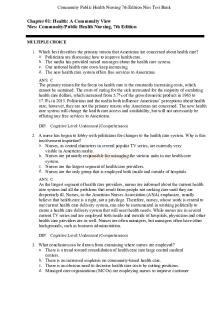
Community Health Test Bank
- 10 Pages

Nurs 2014 community health
- 41 Pages

COMMUNITY HEALTH NURSING NOTES
- 2 Pages
Popular Institutions
- Tinajero National High School - Annex
- Politeknik Caltex Riau
- Yokohama City University
- SGT University
- University of Al-Qadisiyah
- Divine Word College of Vigan
- Techniek College Rotterdam
- Universidade de Santiago
- Universiti Teknologi MARA Cawangan Johor Kampus Pasir Gudang
- Poltekkes Kemenkes Yogyakarta
- Baguio City National High School
- Colegio san marcos
- preparatoria uno
- Centro de Bachillerato Tecnológico Industrial y de Servicios No. 107
- Dalian Maritime University
- Quang Trung Secondary School
- Colegio Tecnológico en Informática
- Corporación Regional de Educación Superior
- Grupo CEDVA
- Dar Al Uloom University
- Centro de Estudios Preuniversitarios de la Universidad Nacional de Ingeniería
- 上智大学
- Aakash International School, Nuna Majara
- San Felipe Neri Catholic School
- Kang Chiao International School - New Taipei City
- Misamis Occidental National High School
- Institución Educativa Escuela Normal Juan Ladrilleros
- Kolehiyo ng Pantukan
- Batanes State College
- Instituto Continental
- Sekolah Menengah Kejuruan Kesehatan Kaltara (Tarakan)
- Colegio de La Inmaculada Concepcion - Cebu

